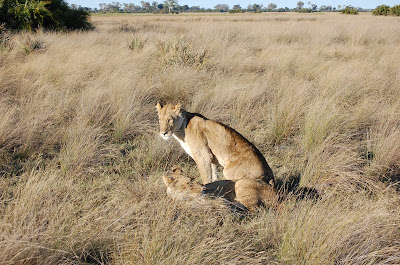Our guide's name was Kampango. We dubbed him the Encyclopedia of the Delta (the Okavango Delta, see Angry Leopard for a map).
On our evening game drive, we saw our first big crocodiles...

...from a safe distance, and we generally surveyed the area - wet with the annual flood and with lots of sand banks convenient for tracking animal prints. We learned that evening that there was an elephant that liked to visit camp to steal the kitchen's toaster to shake out the crumbs for a snack and vervet monkeys that liked to steal pencils from the camp's curio shop (probably for the nice-smelling erasers).
On our morning game drive the next day, Kampango found lion prints through camp.

He circled them with a stick. We actually farther along found a print of an entire lion lying down in the sand, tail and all. Shortly thereafter we found two lionesses in a clearing, bedding down for a daytime nap.

They seemed well-fed and unperturbed by our truck - a mere fifteen paces away. The nearer was the mother, more scarred and larger, and the one farther away her daughter. When they would switch resting positions, they would pause to look around...

...and if they were too lazy to get up, at least one would occasionally raise her nose to smell the air...

...to check for any danger, and though they were well-fed, to make sure a next meal wasn't nearby. We left them to have our morning tea after an hour or so of watching them curl up and uncurl and scan the plain and sleep and roll over.
When we drove back to visit the lionesses after tea, we passed a warthog.

Not the best pic, but that's the one.
A bit later, as we sat watching the lions, the warthog emerged from the brush and crossed the dirt road to eat in the distance. To eyes at ground level, the massive cats were completely invisible in the grass, and they would have been so even from a few feet away because the delta grasses are thick, and the dry grasses are colored like a lion. We wondered if that warthog might wander closer, but it was time for us to go back to camp for siesta.
When we returned from our own naps, the lionesses had moved, and we found the first one drinking from a puddle near an "island" (see the PS) farther into the plain from where they had rested in the morning.

We followed her back behind a bush to her companion, and we realized, they had indeed killed a warthog - a quickly disappearing warthog - perhaps the one we saw earlier in the day. Note the tusks...



...and consider that a warthog weighs about 100-120 lbs. These cats each ate 50-60 lbs of meat and bone in about a half hour. They did not, however, eat the tusky skull.
PS
When we arrived in the Delta, we were amazed at the size of the termite mounds. It also seemed counter-intuitive that a tree could be growing in a termite mound. We hypothesized that the termite mounds were situated around trees (that were eventually eaten), and then the termites moved on once the food (the tree) was consumed.
As it turns out, we were backwards - the trees came after the termites. Kampango gave us a detailed lecture. The termites are considered the chief "architects of the Delta". The vast majority of these "islands" with trees are due to the termites.

A male and a female termite - the kind and queen - travel together if they are lucky to a new spot. They dig a little hole for themselves in the dry season, and then the queen begins laying eggs. Typically about 200,000 eggs per day.
They are harvester termites that help to process animal wastes on the Delta (hippo dung especially), and then they build up a nice mound. Animals and birds rest on the mounds and deposit seeds via their doodies. Hee hee. Then in the rainy season, the mounds are battered by the rains and they spread out and down, along with the doodie-deposited seeds. The termites build and build their mounds again the following year, and over time, you end up with a massive mound of sandy matter sprouting trees, bushes and grasses - an island in the Delta.

PPS
Mom, you were asking about the trucks we rode in. Yes, sorry, they were/are totally open.

No comments:
Post a Comment